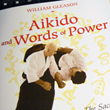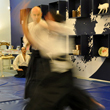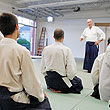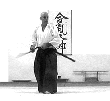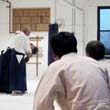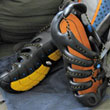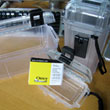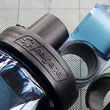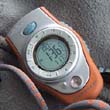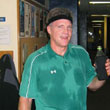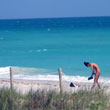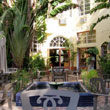|
|
 |
RainyDayMagazine's content can now be licensed for your print magazine or web site. Please contact us directly here. If you want to see something reviewed, then drop us a note with a link and we'll be happy to take a look.
NOTE: Click here to read more about our approach to product reviews. |
|
|
| Dec 3, 2010- Rainy Day Gift Guide: Sports... |
We thought a bit about what we should include in this year's RainyDaySports gift guide. We had a lot of possible suggestions on cool but expensive gear. However, with the current fiscal condition and general economy, we thought we would scale back on things with large price tags. So the general theme this year is about accessories, not big ticket items. In that spirit, we hope you enjoy the recommendations.

We looked a lot at sunglasses this year, specifically replacement lenses for Oakley's Juliet frame. There are a few third-party replacement lens makers out there, but we think the offerings from Visionary Lenses are the best. We like this company because they offer the... [more]-Holiday Gift Guide: Sports
|
|
| Nov 16, 2010- Ski & Snowboard Expo... |
The weather was a balmy 55º today in Boston, but that did not stop the wintersports enthusiasts from turning out for the 29th Annual Ski & Snowboard Expo (running over the weekend). It was the place to be for anyone looking for a deal on ski packages, day passes, or gear. Resort owners, ski lift operators, and others with a stake were out in force with plenty of tempting offers, package deals, and season discounts.

Skiing is a huge business for New England, even for the smaller operators. There was some worry that the slow(er) economy might make folks cut back on discretionary spending, thus spelling doom for the small family-run outfits. Funnily enough, the smaller ski-area operations have seen a resurgence because of the weak(er) economy. For the past few years, families have opted for the lower prices, shorter lines, and homier charms at these smaller places. The greater-than-normal... [more]-Ski & Snowboard Expo
|
| Oct 13,2010 - Contrast Enhancing Lenses... |
Sunglasses are standard equipment for any excursion to the beach. Since we knew we would be right next to one for a few days for Columbus Day weekend, we brought along a few pairs (Julbo, 180s, TruFocals, Oakley) to do some side-by-side InTheWild comparisons.
Of special interest were the TruFocals and contrast-enhancing lenses for our Oakleys.

We did a FirstLook review of the TruFocals and have been wearing them a few days a week for the past two months, but only indoors. This is because we wear contact lenses during the day and the TruFocals at night. We love the "teashade-ish" look of the TruFocals. They remind us of the glasses worn by Seraph in the Matrix. Of course, the ones worn by Seraph were... [more]-Contrast Enhancing Lenses
|
|
| Oct 4,2010 - Shobu Aikido: Fall Gasshuku... |
Those of us who are in Boston know what a priviledge it is to be able to train under Sensei Gleason all the time. A few times a year, Shobu Aikido hosts a weekend gasshuku (intensive seminar). Often these seminars are taught by visiting teachers. However, this Fall the gasshuku will be taught by Sensei Gleason. It will be three days of training. To get the most out of the seminar, attendance for all three days is highly recommended.

If you are interested, go sign up now on the Shobu site. While the dojo is pretty large, spaces fill up fast. Fee for the seminar is $100. Individual days are available. You can register online through the calendar at www.shobu.org. Please call 617-718-1918 or email Shobu Aikido for more information. [Permalink] -Shobu Aikido: Fall Gasshuku
|
|
| Oct 1,2010 - Aikido3D:A New Point of View... |
We recently got into a brief discussion online about what it means to be "in control." After 10 years of Aikido practice, the one thing we have learned is that you can't control others. Control through force is an illusion, because it is weak and temporary. Real control is the lack of the need to control because the compliance is offered freely.
In Aikido, Sensei Gleason often reminds us that we can get out of their way when opponents fall, but we can't make them fall. Ever tried shoving a tree? A sand dune? or water in a swimming pool? That is the feeling you get when you try to shove someone who knows how to absorb and redirect that energy. The end result is usually that the person shoving does the falling, and the other person just steps out of the way. The feeling of falling is exactly what you experience when part of a well-executed Aikido "throw." The attacker falls because they lose their balance and are tripped up rather than thrown down. This is an interesting but often misunderstood distinction when trying to learn the essense of or the "secret" to Aikido techniques.
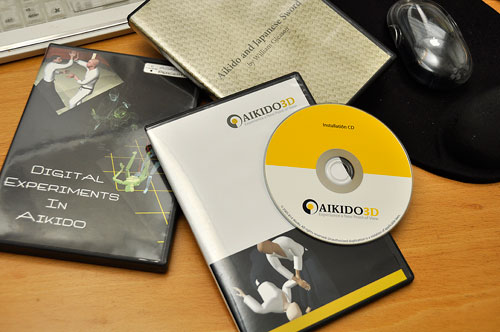
Those who study the martial arts know it is next to possible to learn by reading books or watching videos. They are merely mechanisms to help with visualizing the basic forms or to supplement the description of the movements.They fall short as good teaching tools because they can only offer a snapshot of movements in time or a point of view from a single perspective. Still, it would be helpful to have an effective way of showing various techniques and concepts without having to have it demonstrated live. The most innovative approach we have come across to date is a training program called Aikido3D.

Aikido3D is a new, computer-based instructional aid which is very different from all other teaching tools currently on the market. A few years ago, we looked at a DVD called Digital Experiments in Aikido (DEiA). Aikido3D is similar in some respects to that effort, but it has vastly extended the interactive nature by enabling the viewer to manipulate the camera angle in real time. This capability is tremendously helpful as an exploration and learning mechanism.

The sequence above is just three (top, front, angled) of an almost infinite number of possible views of the start of the koshi-nage technique. The controls can show/hide the hakama, the participants, and/or their footprints. While not exactly like the center-of-gravity analysis from the DEiA, Aikido3D can also show the "one-point" radiating from the center of both participants. This is helpful in illustrating the forward direction of the two participants relative to everything in their surroundings.
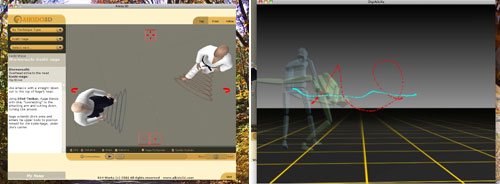
The on-screen controls are intuitive and easy to use. Sometimes, if the camera's zoom factor is set too high, one can get "lost" in the scene. Clicking on the "center it" button in the middle will always bring things back into view.
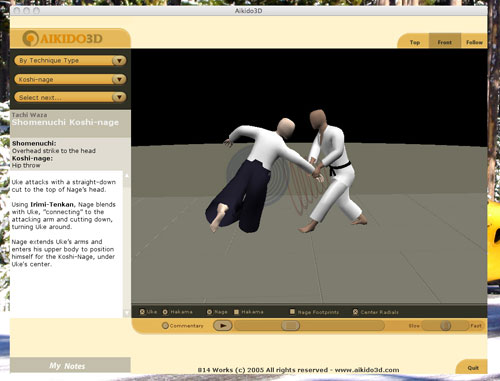
The sequence below show the koshi-nage technique just before the actual throw. The action can be stopped at any point and analyzed. We grabbed a few different angles to show the power of the Aikido3D approach. The ability to study a technique in such detail has never been available before to anyone but live-in students of a dojo.
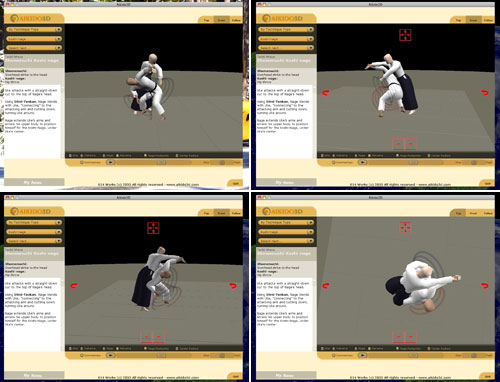
Of course, there is still quite a bit missing from Aikido3D when compared to live instructions. However, we also see tremendous potential in the approach used in Aikido3D. We would love to see a force-vector overlay showing the direction of the ki-extensions at the various points on the nage's body. Using the Koshi-nage as an example, we would want to know: Is the weight resting on the right or the left foot of the nage during the throw? Is the direction of the force of the arm above extending out and upward or going down toward the ground? etc... These points have traditionally been left for the students to "discover" for themselves during their training. That approach is an inefficient means of transferring knowledge. The study of hand-to-hand martial arts is not widespread today. Most students do not study the martial arts as a vocation and often are not able to make these discoveries on their own.
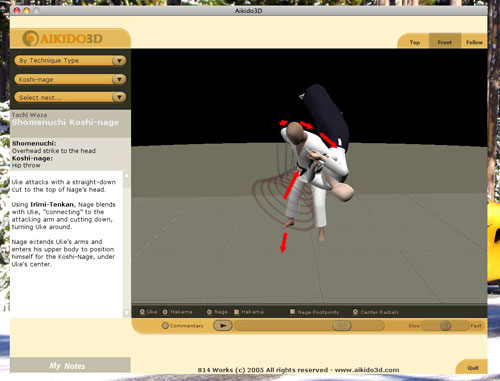
The only effective way at present to acquire an understanding of Aikido or any martial art is to learn from a sensei and train with a more experienced partner. This is because what truely makes martial arts effective is often obscured by what is happening on the surface. Where is the point of balance? How is the extension being projected? What does it feel like during the moment of contact? These points are difficult to understand without actually feeling them first-hand. Future computer-based tools may one day give skilled practioners the mechanism and means to describe, record, illustrate exactly what is happening behind the scenes. When that day comes, the "secrets" of Aikido may finally be easier to reveal to others. Those interested in getting a glimpse of what that future should take a look at Aikido3D today. [Permalink] -Aikido3D: FirstLook
NOTE: The Aikido3D disc is platform specific (Mac or Windows), so be sure to order the the right version. We don't know if a version is in the works, but it would be awesome to have it on the iPad. |
|
|
| Sep 10,2010 - Homedics Restore FirstLook... |
At the start of the Summer, we gave a quick mention to an interesting water filtering system named Restore from HoMedics. This water-purification pitcher uses an activated-carbon filter similar to many others on the market. However, they have one notable feature not available in any other system, a built-in germ-killing UV light source. Today, we'll take a RainyDay FirstLook at the HoMedics Restore system.

The HoMedics Restore clean water system is made up of a few simple elegant parts: 8-cup pitcher, filter, lid, AC adapter. The pitcher is visually appealing, feels substantial but not too heavy. The handle is rubberized and very comfortable to grip. At the base of the handle is a switch for the two modes: Purify, and Fill. The pitcher is bottom-heavy as the circuitry for powering the UV bulb is in the base of the unit. There are two steps to the HoMedic Restore process: activated-carbon filtration, and UV light sterilization. Water to be treated goes into the top reservoir, flows though the filter, and is UV-treated in the lower chamber. Once treated, the water may be poured directly from the pitcher. The pitcher may also be unplugged from the adapter and the entire unit placed into the refridgerator for chilling.

Most home filtration systems do a great job of getting rid of odd tasts and odors from the water. Many of them also get rid of other contaminants such as zinc, lead, and other chemicals. However, the activated-charcoal in the filters does not impact bacteria, viruses, and cysts or any organisms which are small enough to pass through the physical membranes. This is where (forgive the pun) the UV light shines. The HoMedic Restore UV sterilization process is designed to achieve the following:
- Bacteria: 99.9999% or 6 log reduction
- Virus: 99.99% or 4 log reduction
- Cyst: 99.95% or 3.5 log reduction
Here are the basic technical specs for this Restore purification system:
- Recommend use: 2 gallons per day (7.5 liters)
- Filter life: 40 gallons (151 liters)
- Typical Bulb Life: 10 years
However, one must be realistic about the Restore purification system, or any similar countertop filtration units. It is a SUPPLEMENTAL and secondary purification system designed for home use, not something built to take contaminated or untreated water and make it drinkable. These units are best for taking tap water from the faucet and giving it a final scrub before drinking.
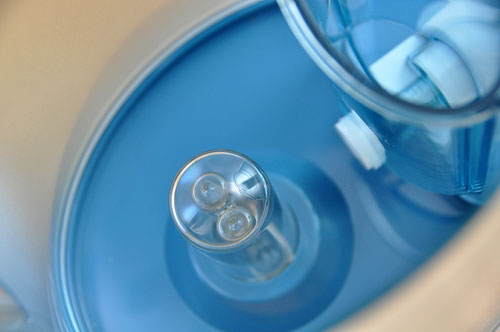
The AC wall adapter is a controller and power converter in one. There are three buttons (Purify, Reset, Cups Per Day) on it and their functions are self-evident. The adapter has a convenient retractable cord (which accounts for its unusually large size). In the back of the unit is a small cover for a battery. There was no mention of the function of this battery, but it probably has something to do with remembering the settings when the unit is not plugged into the outlet.
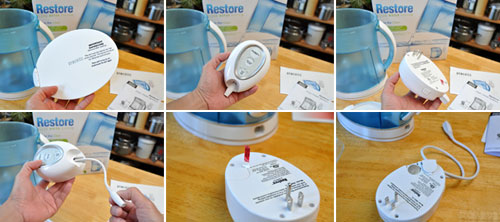
The prep and set up for water purification was very simple. The first step was to prepare the activated-carbon filter for use by soaking it in water for about 10 minutes. This was to ensure that the filter is evenly moistened prior to its first use. The filter chamber is in the rear of the pitcher. Note that the bottom of the bowl is slightly sloped toward the rear so the water will flow into the filter.

The instructions recommend that the first two full pitcher of filtered water not be used for drinking as loose carbon particles will be flushed out of the new filter. We also recommend washing out the top reservoir as there were loose particles floating around there as well.

UV light is generally grouped into three ranges called UVA, UVB and UVC. The “germicidal wavelength” is between the 100 - 280 nm of the UVC band. UVC light works by disrupting the DNA of microorganisms and destroying their ability to multiply. UVC light has been used to effectively disinfect and sanitize surfaces in hospitals and laboratories for years. The technology has been well proven in industrial settings.
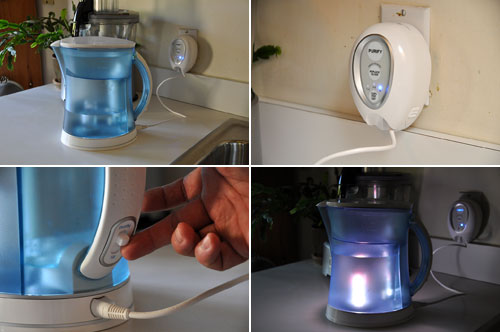
Getting the Restore pitcher ready for sterilization was very simple. Once the 8 cups of water had worked its way throught the filter, we plugged in the cord, flipped the switch in the handle to the upper (Purify) position, and pushed the "Purify" button on the AC wall adapter. The bulb started up with a pink-ish glow and quickly shifted to a bright blue hue. The entire Restore UV sterilization cycle lasted about a minute. Once the light goes out, the water has been sterilized and the purification process is complete. At this point, the water is ready for consumption.
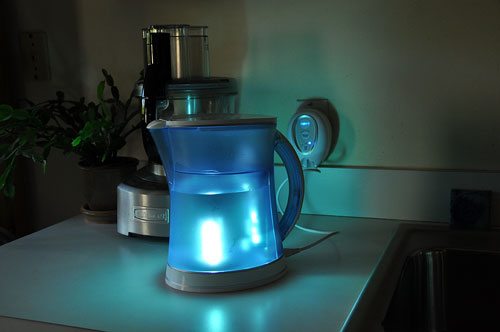
Normal filtration works by removing contaminants in the water by physical (size) or chemical (activated charcoal) means. By combining filtration and UV sterilization technologies in an easy to use format (i.e., the ordinary water pitcher), HoMedics has made this proven commercial purification technology available to the consumer. Restore is California-certified for microbiological water purification, a first for a water pitcher utilizing UV technology.
We'll let you know how the taste compares to our other filtered water in the head-to-head comparison. Look for it in the Fall. [Permalink] -Homedics Restore: FirstLook
|
|
|
| Sep 6,2010 - Visionary Lenses: Wild colors |
Our newest (to us) pair of Oakley Juliet sunglasses was procured in July. The pair came with a few issues but we were able to fixed it up quick with parts from the Oakley store. We were all set to replace the lenses when we discovered that Visionary Lenses have added some new colors to their line up. So we decided to put the brakes on the lens-upgrade project until after we had a look at VL's latest offerings.

We are so glad we waited. What arrived in the mail last week was a batch of brightly colored polarized lenses. Polarization blocks glare off of flat surfaces like snow, water, and road. If you have a pair of Oakley Juliet frame and want to amp up its performance and head-turning factor, you NEED to check out these replacement lenses. Some of the colors are "cool" (Blue, Silver, Green) while others "hot" (Ruby, Fire, Gold).


Compared to Oakley OEM lenses, Visionary Lenses are thinner, but they still retain an extremely high level of impact resistance. Some of the lenses will "color-shift" (Ruby, Fire, Green) depending on the view angle to the lens. After much deliberation, we decided on Ruby as the replacement color for our new Oakley frame. While the red of these ruby lenses are not as deep as those of Cyclops in X-Men, they still look fantastic, especially when viewed head-on. Because the VL lenses are thinner, they also fit into the frame much easier. With the ExoVista and Caulfield lenses, we had to work to get them into the frame. These VL lenses just slipped right in. The fit of the VL lenses is PERFECT. There is absolutely no movement once the retaining screw has been tightened. Of the three installations we have done, this was the easiest by far.


Visionary Lenses have recently invested in new equipment to further expand their lens-coloring and manufacturing capabilities. We are looking forward to seeing what new hues will be available as a result of their upgrade. Got a color suggestion? Let us know! We hope to get some photos of their new equipment in action to give readers a better understanding of the overall lens making process. We find the topic fascinating. If you do as well, then look for the article in the Fall. [Permalink] -Visionary Lenses: Wild Colors
|
|
|
| July 27,2010 - Visionary Lenses FirstLook... |
A few days ago we picked up another pair of Oakley Juliet sunglasses on Craigslist. It was not that we needed another pair, but that we wanted an extra pair so that we could do side-by-side comparisons of replacement lenses from different vendors.

In our search for aftermarket replacement lenses for the Oakleys, we have found a few vendors (ExoVista, Caulfield) with quality products. After reading our write-ups on them, a reader told us about Visionary Lenses and recommended we take a look. We checked out the site, liked what we saw, and decided to get some lenses in house for a closer look.

All of the lenses that Visionary sells are polarized, offer 100% UV protection, and are impact-resistant to ANSI standards. The coating is made with an 8-base cure (same as Oakley's) and transmits 10-16% of the available light. The multi-layering technology used to apply the coating to Visionary Lenses results in more vibrant hues. All of VL's lenses come with a VL microfiber soft-cloth transport bag, replacement tool, and a 15 day money back guarantee.

As we now have three pairs of blue lenses (Caulfield, VL, Oakley), we can do our side-by-side bench comparison. However, because we only have two frames, we will only be able to install two of the three sets for the daily-wear test. Since our original intent was to find aftermarket options to the higher-priced OEM lenses, it made sense to put the VL iridium lenses into the new frame and compare them to the Caulfield ones.

The wear-tests are scheduled for the Fall. We are not going to start them right away because we want to check out some of the other colors (Green, Ruby) in the VL collection. Those colors did not get here in time for the VL FirstLook, but we'll install them and check their fit for the FirstUse test.

When we got the new Oakleys (new to us, but have been used for a while from the looks of the rubber parts), we noticed that one of the nose pieces was missing and the the rubber "socks" on the arms were a little worse for wear. A quick search on eBay showed a bunch of sellers with replacement parts. As we really didn't want to wait, we checked with the local Oakley store. Much to our surprise, the Oakley store prices were actually CHEAPER than eBay! The kit came with two sets (only one set shown) of nose pieces and two earsocks...all for just $10.

There are a lot of aftermarket vendors making Oakley replacement lenses. This is great because it gives Oakley owners many more options (colors, price, convenience) for maintaining, repairing, and customizing their sunglasses. Readers interested in learning more about Visionary Lenses' green or ruby lenses should keep an eye out for the follow-up article. If things stay on schedule, we hope to have it ready for you before the end of August. [Permalink] - Visionary Lenses FirstLook
|
|
|
| July 23,2010 - TruFocal FirstLook... |
It has been said that the day you turn 40, your eyes immediately require the aid of "reading glasses." We didn't believe in such things and have been blaming the restaurant's romantic lighting for not being able to read the menu, the low ppi on the monitor for the fuzzy screen, and having too much coffee for not being able to put the thread through the eye of the needle (we stitch up our own wounds here at RainyDayMagazine).
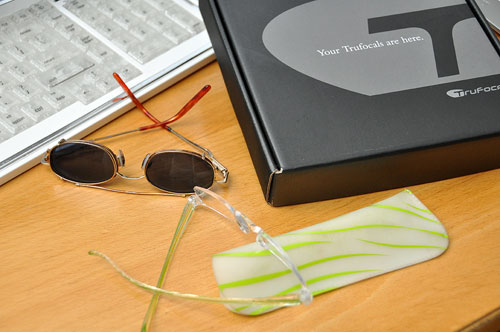
Those excuses worked for a while, but some of the editors had to face the fact that they either had to increase the font size on their screen or get a pair of decent reading glasses and get on with life. Having opted for the latter was a step in the right direction, but it spawned another problem...reading glasses of different prescriptions started multiplying around the office like bunnies. Reading glasses are only good for seeing clearly at one fixed distance. If you want to read, see the computer screen, and do close-up work, three pairs of glasses are (possibly) required. Carrying three pairs around is not convenient, so leaving them all over the place is apparently the standard solution. Actually, there is another solution... TruFocals.

Presbyopia: an age-related, progressively diminished ability to focus on near objects, caused by a decline in the ability of the eyes’ lenses to increase their curvature…..and, hence, to focus in closer.
Over time, our eye's lens becomes increasingly less able to change shape. So, as we age, we lose our ability to focus to close distances. This problem is a natural consequence of aging and will happen to everybody. Most people first notice this in their 40's... when they can no longer read print comfortably. By about age 65, we have lost most (but not quite all) of flexibility in our eyes.
TruFocals were invented to address this problem. Each "lens" is actually a set of two lenses, one flexible and one firm. The flexible lens (nearest the eye) has a transparent, distensible membrane attached to a clear rigid surface. The pocket between them holds a small quantity of crystal-clear fluid. As the slider on the bridge is moved, it pushes the fluid and alters the shape of the flexible lens. Changing the shape changes the correction. This mimics the way the lenses in our eyes used to perform when we were younger. This allows the wearer to choose the exact correction that works best at any give distance and under any lighting conditions. The result: clear, undistorted vision over a wide field of view: no zones, no lines, and more importantly, no need for spectacles in every room for every task.

TruFocals' front lenses corrects for the wearer's far vision and protects the flexible inner membrane. The front lenses are magnetically attached and easily removable for cleaning. Note the ridges on the edge of the lens. They make the lens easier to grip.

There are six magnets embedded in a ring at the rim of each lens. Each lens has a tab so they will properly align with the frame. The easy way to differentiate the left lens from the right is to just orient the tab toward the bridge and let the magnets "click" the lens into place. The tab will automatically make sure the lens is properly oriented (especially important for those of us with astigmatic prescriptions).

The flexible membrane is sandwiched between two metal rings. Even so, the rear assembly is pretty thin. The overall thickness of the TruFocals is really dependent on the wearer's prescription. We have a -9 correction so our front lens is rather thick, but not any thicker than our regular prescription glasses, and thinner if you include the sunglasses overlay.

To adjust the correction, all the wear has to do is move the little tab in either direction. This can be done while the glasses are being worn. The slider is a little stiff right now probably because it is new, but we expect that will ease with use. The advantage of the TruFocals over any of the other multi-focus options (bifocals, trifocals, progressives) obviously is that the entire field of view is in focus. There is no need to tilt your head up and peer down through the glasses to see things clearly.
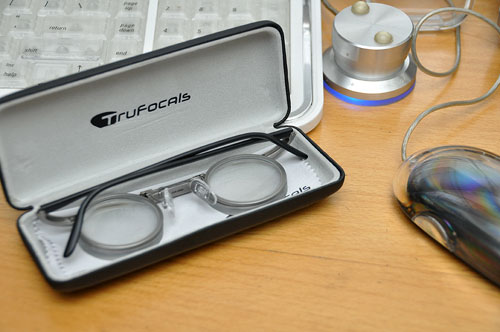
We will be giving up our contact lenses for a few hours each day and wearing these TruFocals. Look for the FirstUse report in a few weeks. We should have the InTheWild review posted before the Holidays (should anyone wish to put these on their gift list...hint, hint). [Permalink] - TruFocals FirstLook
|
|
| July 21,2010 - Water water everywhere... |
Most folks in the US don't think about the quality of the water they get when they turn on the tap. Drinkable water from the faucet is expected. Earlier this Spring, a huge pipe which brings clean water into Boston burst and plunged the city into a water emergency. For a few days, residents had to pay a little more attention to their water. As it turned out, the water supply was fine and no one was really at risk during that period. However, we did field a bunch of questions about water filtration and the like. As the weather now hovers in the 90's more often than not, we thought it timely to talk a little about proper hydration and water-related topics.

While the water from the tap is usually very clean, it might not be very tasty. Sometimes it is because the pipes are rusty. Other times it may be due to the clorination or other processing residues. None of it is particularly harmful, but it can alter the "character" of the water. For great tasting water, running it through activated charcoal will usually take out any odor or odd taste. One convenient way to do that is to put a filter on the faucet. While this is possible at home, you can't do tht when you are out an about. This is where something like the Hydros portable filter comes in handy.
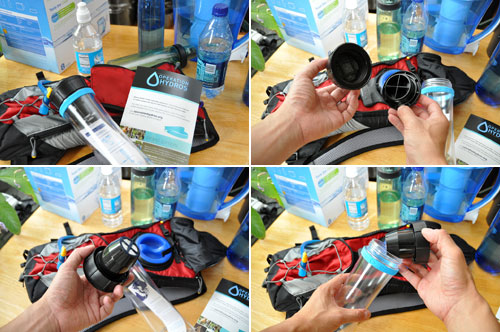
Hydros is a BPA-free plastic water bottle that has an antimicrobial FastFlow filter as a cap. The reusable filter water bottle is made from Eastman’s Tritan™ plastic, which is chemical and heat-resistant. Dropped it? It won’t break. Dishwasher safe? Of course. When the Hydros people say the filter is fast flowing, they are not exaggerating. Hydros' Fast Flow Filter™ technology reduces contaminants from tap water quicker than the typical pitcher filter. The filter uses IonArmour's natural, triclosan-free antimicrobial technology, which actively defends against odor-causing bacteria.
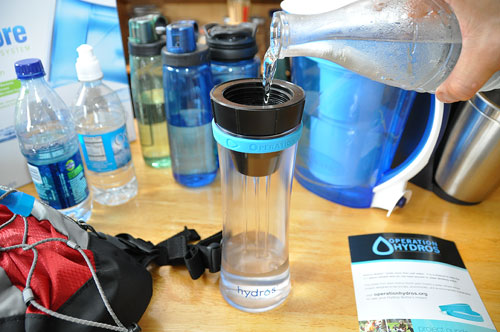
IonArmour®-enhanced products work by using an infusion process that durably embeds microscopic active particles into surfaces, the very places where microbes normally flourish. An untreated water filters can start to smell a little funky after a while. Surfaces of the Hydros filter are infused with these antimicrobial particles and are protected against microbes for the natural life of the product.
Having a fast flowing filter is great. We wished it would fit some of our other plastic bottles. Even though the Hydros' filter will not screw onto any of our Nalgene bottle, it will fit the openings. If we are careful, we could even use it with our CamelBak pack.
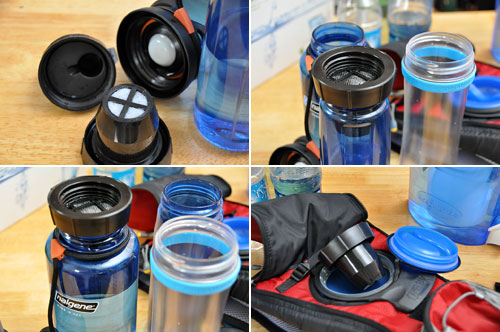
Buying and using a Hydros bottle does more than just reduce the plastic waste associated with disposable bottles. One dollar from each Hydros bottle goes toward a water infrastructure project designed to be socially, economically, and environmentally sustainable. An example is Gundom, Cameroon, where 2 in 5 children drink unsafe water from tiny streams or ponds. Operation Hydros has teamed up with Engineers Without Borders (EWB) to bring clean water to this village.
By donating $1 ($1=2,000 gallons) from every bottle sale, Hydros helps EWB provide potable water that will be available year-round. You can find out more about the Gundom project here.
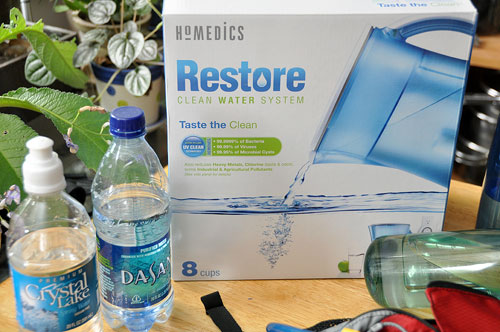
After we posted our FirstLook of the ZeroWater unit in March, we got a few of emails from readers who said we should check out a water purification system from HoMedics called Restore. It should be noted that neither the ZeroWater or the Hydros filters will make microbiologically unsafe water SAFE to drink. The Restore system's difference to the other two is that it cleans the water by combining germ-killing UV technology with a water filter. So in addition to removing chemicals and particulate matter from the water, it also actively kills bacteria & viruses which may be too small to filter out using the standard passive methods.

All of this water talk is making us thirsty. We'll go hydrate and will come back and take a FirstLook at the Homedics Restore filtration system next week. There are some difference with the ZeroWater unit which we'll highlight in the FirstLook. In the meantime, don't forget to drink plenty of water and stay cool. It's hot out there. [Permalink] - Water water everywhere...
|
|
|
| July 13,2010 -CRKT:Lumabiner, ZillaTool jr... |
When we go out on location, we bring a lot of gear. We might forget to bring a cable, extra batteries, something...but we never forget to pack a multi-tool. There are quite a few to choose from in the equipment locker, but the two we take most often are the CRKT Lumabiner and the ZillaTool Jr.
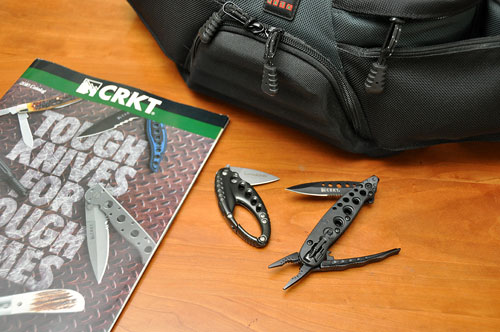
We take the Lumabiner because it is easy to hook onto just about anything: belt loop, car keys, bag handle. The ZillaTool Jr. gets the nod because it fits perfectly on the strap of our favorite photo bag. We take them so often that they rarely see the inside of the equipment drawer. Other multi-tools may have more functions, but because these two are so perfectly sized for everyday carry, they are the ones which get used most often.

The ZillaTool Jr. is the little brother of the ZillaTool. The one we have has a black bead-blasted surface. The matte finish is great for when we are photographing as it won't accidentally spook our subjects (birds, deer, people) with unexpected reflections. The tool weighs only 3.8 oz and has an overall length of 5.25" when closed and 7.5" when fully open. Its functions are:
- Pliers: spring-loaded
- Knife: 2.25", black, non-reflective
- Screwdriver bits: flat, Phillips
- Wire cutter/stripper
- Bottle opener
The steel blade opens easily with one hand because of the bump near the hinge. It locks into place with a nice click and unlocks easily with the press of the catch lever. The jaws of the needle-nose pliers are spring loaded. They are locked in place by a slide. The jaws have both flat and circular gripping surfaces. At the base of the jaw is the wire cutter.
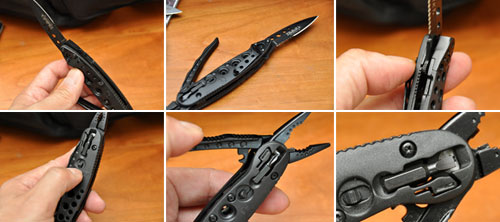
The screwdriver bits are housed in recesses on the side of the handle. The end of the handle has a hex-shaped opening to accommodate the bits. The bits are held in place by a magnet at the bottom of the opening. To make it easy to carry, the ZillaTool Jr. comes with an integrated removable spring clip and a nylon sheath. We find ourselves using the clip almost exclusively.
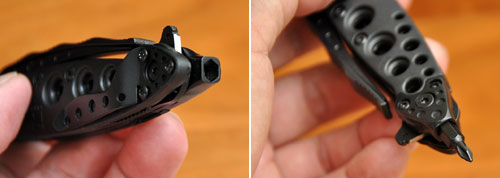
The Lumabiner is a simpler tool, but has two of the basic functions (flashlight, blade) that we need everyday. The Lumabiner comes in a variety of colors. The one we have has a charcoal color body with a matte grey blade. We like this combination as we find it blends best with our gear. The carabiner clips on to any convenient loop. There is a slide that locks the latch so it will not accidentally open. We really like the lock as it ensure that the Lumabiner will be there when we need it.
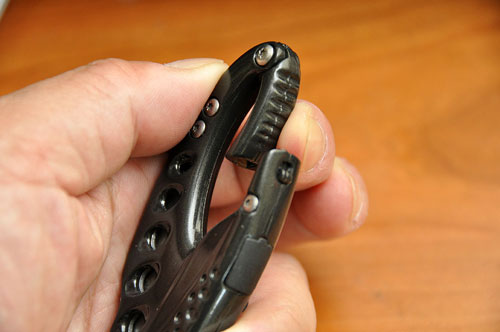
Integrated into the Lumabiner's frame is a bright LED light powered by two small 3V Lithium (CR927) batteries. The round shape fits comfortably in the palm during use. The blade may be opened and closed with one hand thanks to both the thumb studs and the way the blade lock was designed. The entire package weighs less than 2 oz and is just 5" fully open. We found the Lumabiner to be a little big as a key fob, but others have used it as such.
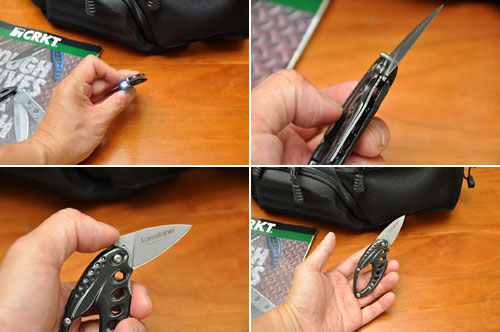
The CRKT Lumabiner and ZillaTool Jr are designed for anyone interested in carrying more than just a sharp edge. Both multiTools are highly portable, very tough, and simple to use. There are a lot of knife makers out there, but CRKT has shown that they are one of the innovators. We look forward to seeing what they will come up with next! [Permalink] -CRTK (Lumabiner, ZillaTool jr ) FirstLook
NOTE: Because CRKT is a brand known for their quality cutting instruments, their products are sometimes counterfeited and sold in places such as EBay and other venues. The looks may be similar, but the quality and workmanship of the counterfeits are guaranteed to be poor and shoddy. If you want to trust your tools, buy the genuine article. You will be glad you did when you are InTheWild.
|
|
|
| July 6,2010 - Flip UltraHD ... |
Summer: beach, barbeque, swimming. These are activities in which many of us will be partaking over the next few months. Capturing the fun in pictures and videos have just been made easier by Flip with their new UltraHD camcorder and underwater case.

We were one of the first reviewers of PureDigital's One Time Use camcorder back in 2006. The One-Time-Use concept was an interesting business idea. The concern at the time was, would the average consumer be savvy enough to deal with digital video on their computer? As it turns out, the answer was a huge "YES." So, Pure Digital started making more sophisticated models and selling direct to the end-user. The Flip was their break-through product and a winner for Pure Digital. Cisco acquired the company in the Fall of 2009 and ramped up the Flip Video product offerings. With five different models in the line up, the pocket-size camcorder has come quite a way since we first looked at them four years ago.

The UltraHD is Flip's second low cost HD camcorder. We looked at Flip's first HD camcorder, the MiniHD, over a year ago. When we first saw these little camcorders, we did not think their quality would be as astounding as they are. While it is true that these pocket camcorders cannot go feature-for-feature with the more expensive units, they do produce videos of comparable quality. The Flip wins on being more portable, less complicated to use, and with the underwater case...splash-proof!
Here are some of the main features of the Flip UltraHD camcorder:
- 1/4.5" HD CMOS Sensor 2.2 µm pixels (1280 x 720 resolution)
- Fixed Focus (1.5m to infinity)
- f/2.4 (fast lens for great results in low-light environments)
- 4.25" x 2.19" x 1.17" and less than 6 oz
- Built-in speaker and stereo mic, tripod mount
- 2" LCD, 320 x 240
- HDMI™ (Mini HDMI) port and integrated USB connector

The Flip UltraHD comes with a set of NiMH rechargeable batteries, but is designed to work with any AA-size power cells. This is a great feature for those not traveling with a laptop or want to pack as lightly as possible. The choice of using AA batteries is an excellent one as AAs are found all over the world.

When we reviewed the Flip MinoHD last year we suggested that an OtterBox1000 was a great accessory for the unit should users wanted to keep it protected in transport. Flip Video has gone further for the UltraHD and has created an affordable underwater housing for the camcorder.

The case is clear and made out of polycarbonate. The main seal runs the entire perimeter of the case and is secured by the cam action of the knob at the top of the case. The housing is spec'ed to be water-tight down to depths of 30 feet. The back panel has buttons to access all of the controls on the camcorder.

Unlike other cases, the Flip video housing enables the user to have access to all of the camcorder's functionalities while encased. While the case was designed for under water use, it will protect the UltraHD from other hazards (mud, sand, snow, etc...). So if you want to take a video camera on a canoe trip, whale watching, or boat ride under Niagra Falls, you may now do so without worry. The one thing this case does not have is a tripod mount. This means that you can't use something like a gorilla tripod to attach it to the mast of a windsurfer or the handle of a dirt bike.

We are looking forward to taking the UltraHD out for its FirstUse. Whether you are heading to the backyard pool, the local beach, or some place more exotic, this Flip UltraHD and waterproof case will let you bring back the action in HD. [Permalink] -Flip UltraHD
|
|
|
| June 30,2010 - Julbo Zulu: FirstLook ... |
Sunglasses are standard equipment for many of our rigorous outdoor activities: backyard BBQ-ing, looking for fried clams, and top-down driving. To those ends, we have reviewed quite a few pairs of sunglasses (180s, Oakleys, etc...), especially the ones with more than just great looks. The three greatest sunglass innovations were probably: polarization (for glare reduction), polycarbonate (for strength), and photochromic lenses (for auto-darkening). It has been a while since we have seen something new under the sun (excuse the pun) when it comes to sunglass technology.

Traditional light-sensitive lenses are actually responding to the amount of UV light. This was fine as UV light is usually mixed with visible light in most situations. However, this is NOT true when driving some modern cars, because some modern windshields have a built-in filter for UV light. The UV filter helps extend the life of the dash material and protects the color of interior. This is great for the car, but messes with the light sensitivity of certain photochromic lenses. This was why our interest was piqued when we heard about Julbo's new sunglasses made using NXT-based photochromic lenses which change based on the amount of visible light.

High impact-resistant optical polymers such as CR-39 and Polycarbonate were developed over 40 years ago. Since that time, there has been little innovation in this area until the NXT. This patented family of polyurethane optical polymers is transparent and unbreakable. NXT was originally developed for the military as an advancement over polycarbonate. It is now finding its way into more and more everyday optical products. The following are some of the benefits of NXT:
- NXT is lighter and stronger than Polycarbonate.
- NXT is free of stress with superior optics.
- NXT has uniform color regardless of the prescription
- NXT eliminates the costly step of tinting

The creators of the Falcon lens have, by integrating the photochromic pigments into the NXT material, created a light sensitive lens which is more than just a dye coating on the surface. This layer will not scratch off, react to chemicals, or be affected by changes in temperature. Unlike UV-activated photochromics, the Falcon lens’ darkening ability is not affected by the UV filtering of the windshield. Julbo calls this "Behind The Windshield" (BTW) technology as it will react to visible light coming in through the windshield. Depending on the amount of light, the Falcon lens will block between 80% to 91% of the light. Since the reaction is activated by visible light, the change in color density of the lens is the same whether it is in direct sunlight or behind the windshield of a car.

The Falcon lenses are exclusive to Julbo for now, but will no doubt be available to other sunglass makers in the future. The Julbo Zulu is the only one in the Julbo line with the Falcon lens at this time. However, Julbo will likely offer this option in their other styles soon. We are looking forward to giving these Zulu sunglasses a full top-down test the next few months. We will report back in the Fall on how they fare InTheWild. [Permalink] -Julbo Zulu: FirstLook
|
|
|
| June 25,2010 - Caulfield Lens Installation ... |
We are starting a tradition of replacing our Oakley lenses on the Solstices (Summer, Winter). Summer officially started on Monday, but we didn't get around to it until today. We replaced the OEM lenses we had on these Oakleys in November with lenses from ExoVista because they had gotten scratched up pretty badly by our not using the microfiber case when stashing them in the door pocket of the car: the sunglasses bounced around and got nicked up enough to obstruct the view during wearing. We were more careful these past six months and the ExoVista lenses those came through unscathed.

In March, we told you about the Oakley replacement lenses made by Caulfield of New Zealand. They were the least expensive ($35) replacement lenses available on EBay. So we were naturally curious as to how they would measure up. The FirstLook was promising. Now it's time to see how well they fit the frame. After six months of use, we will know how durable they are.

We have detailed the lens removal/installation process a few times (Oakley, ExoVista) so we won't dwell on the obvious steps. Suffice to say, use the right tools (Torx T6 bit) and work on an uncluttered surface because the screw and gasket will fall out and to quote Treebeard, they are "very very small." This time we will try to give a few tips on how to make the procedure easier to do.
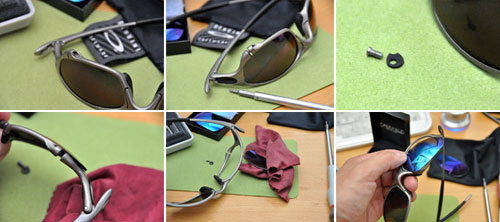
The easiest way to remove the lens is to first pop out the edge closest to the arm because that area has the most give. Once the lens was no longer entirely in the frame, we gripped the lens with a cloth and slid it out. We encountered more resistance with the ExoVista lens than we had with the Oakley one, but was able to remove it without causing the lens or the frame any damage. To put the the new lens in, we reversed the steps and started by anchoring the edge closest to the nose piece first and working our way toward the screw end.

These new lenses fit perfectly. While doing the lens replacement, we did make a new observation which might save folks some headaches: the rubber gasket is not symmetrical. When everything has been reassembled, there should not be any bits sticking out. If it is protruding, it probably means that it was put in reverse and needs to be flipped.

We will be wearing these ice blue lenses from now until the Winter Solstice. We will try to remember to store them in the microfiber pouch when not being used, but they will not be handled any more delicately than they have had in the past. We'll see in six months time how well these lenses stand up to the wear and tear of daily use. If you want to get yourself a set now, head on over to EBay, search for seller "bigdaddyjj" and tell him the folks at RainyDayMagazine sent you :-) [Permalink] -Caulfield Lens Installation
|
|
|
| May 26,2010- Cold Blooded X Jacket FirstLook... |
Clothes that are worn often should fit as well as possible so that we will be comfortable, be made of better material so that they last longer and function better, and should look great...because who doesn't want to look great as often as possible? For a piece of clothing to satisfy all of these parameters it would have to be tailor-made. Since proper measurements and skilled labor are required for a good fit and proper construction, custom-fit, tailor-made clothing is typically quite expensive. It is no surprise that tailor-making is reserved for things like really nice suits or formal wear (tuxes, wedding gowns, and the like). Rarely would someone bother going to all that effort and expense for a fleece or Gore-tex jacket. However, we maintain that it actually makes sense to have something custom-made if one plans on wearng it often. And this can be be an economy - if it fits well and is made well, then a piece of clothing will be worn often and for a long time, no replacement needed.

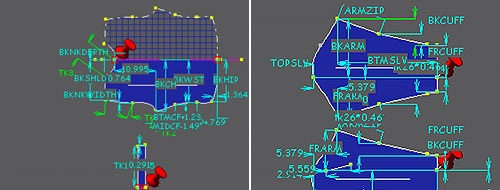
BeyondClothing, with the assistance of CAD-CAM tools and the reach of the Web, is able to bring the cost down to a point where custom-made outdoor wear is quite affordable. Using custom software and the latest in laser-guided technology (see their videos of embroidery and cutting), Beyond is able to offer a fit not possible with off-the-rack gear. Granted, there's a lot of questions to answer and measurements to provide when ordering, but sizing parameters are inter-dependent and having more info will enable the software to better optimize the fit. How and where to measure is clearly explained and very simple to do.

We reviewed the Olympus jacket from Beyond in 2006. Since we last looked, BeyondFleece has changed their name to BeyondClothing to reflect their new offerings. They have also built quite a reputation with climbers, hikers, and nature enthusiasts as the leader in custom outdoor apparel.
Since it is May in Boston, the early morning temperature can be 30-40º cooler than the forecast for the day. Readers may be interested to learn that Beyond is the official manufacturer and supplier of U.S. Special Operations forces Custom PCU Cold Weather Layering system. Given that that's the case, we are confident that Beyond has a jacket which would work well for keeping out the chill during our early morning Vespa rides.
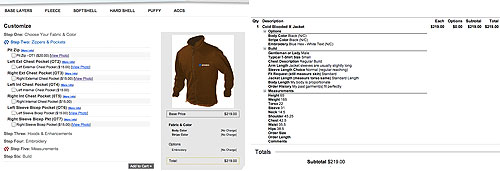
We took a look and thought the Cold Blooded X Jacket would be a good candidate. The X Jacket has two fleece layers: an inner fleece that wicks, an outer fleece that is water resistant, sandwiching a 100% wind-proof middle membrane. According to Beyond, it is also the warmest fleece on the market. We drew straws to see whose measurements we would use for the jacket. Hmm, our managing editor is always very lucky in these office lotteries... Anyway, the site walked us through their five customization steps (color, pockets, enhancements, embroidery, measurements) and the jacket showed up a few weeks later.

It was easy to see the quality and attention to detail on this Beyond jacket. The workmanship was excellent and the materials used were top grade. We ordered a lot of options with our first Beyond jacket, but for this one we kept it simple with just two side pockets. The embroidered logo was very crisp, and there were well-finished seams and high-quality stitching throughout the jacket.

Where the jacket truly shines was its excellent fit. The shoulders and chest were comfortable, but not loose. The sleeve length was exactly where we wanted it. We also appreciated the high collar which covered what the helmet did not.

We ordered the jacket a little shorter so that it would fit better in a sitting position (i.e., when riding the Vespa). The two-way zipper made it easy for the front of the jacket to lay flat, which keeps the cold air from getting underneath. The sleeve length was perfect, long enough without riding down to the palm and interferring with working the throttle or brake levers.

Riding a Vespa for short trips into the village makes so much more sense than driving a car. With the Vespa, we get about 70-80 mpg, don't have to worry about finding parking, and even at a top speed of 35 mph, can get around faster because we can ride around the traffic instead of waiting in it. Having the Cold Blooded X Jacket just means we will be more comfortable while doing it. Besides getting a great jacket from Beyond, the shipment came with a few stickers, which we were happy to add to our collection on the Vespa.


If one considers that an off-the-rack fleece jacket can be in the $100 to $150 range, a custom-fitted X Jacket is actually a bargain at $219. We will probably get another few weeks of use out of the jacket before we put it away for the Summer months. However, in New England, Fall comes pretty quickly. Before long, the temperature will be cool again. With the Cold Blooded X Jacket, we will be ready :-) [Permalink] - Cold Blooded X Jacket FirstLook
|
|
| May 13,2010- StrappedForTime ... |
Wristwatches are a gadget which, technically speaking, none of us need any more, but we (like many of you) can't seem to give them up. The correct time is readily available from our cell phone, Blackberry, or any number of other gadgets we carry with us. However, if we were only allowed to have one gadget on a desert island, a wristwatch would seriously be considered. Well, either a wristwatch or a good multi-tool.

If it was going to be a wristwatch, we would want it to have an "adventure-ready" strap: comfortable to wear, able to handle harsh conditions, and looks great all the time. The place to go to find such straps is StrappedForTime. They have a huge selection of styles that can turn any watch into an adventure-ready watch. One can choose amongst waterproof leather bands, military-style bands, and a host of other materials and styles. We picked a few great looking rubber ones to see which would work best with our YES Tati and Cozmo watches for this Summer.

The YES watches (Tati, Cozmo) came with diver bands. They work just fine but never felt quite right. The Tati/Luna band was a bit on the thin side for our taste, and the Cozmo band was very stiff. We wanted to update them with something more comfortable for extended wear. For comfort, it is hard to beat silicone, and StrappedForTime has a great selection of them. The only downside is that silicone bands tend to pick up lint easier than other materials. If that bothers you, just avoid the black ones and get some other color. Besides, these bands will be getting wet and dirty, so what's a little lint?

We have done plenty of articles on how to change bands, so we'll not repeat the steps here. We do want to show some before/after shots of the watch after swap. The strap we chose for the Tati is the grooved black rubber strap ($25). It is smooth on one side and grooved on the other, very flexible, and perfectly sized for the Tati. It also has a brushed stainless steel flip-lock clasp with a push button locking closure. We think the 4.5mm band looks much nicer with the thicker lugs of the Tati than the thinner OEM band.

The YES Cozmo has a much thicker case, so we paired it with a heavier 7mm thick silicone band. The Cozmo has a nice blue accent on the bezel so a blue band would bring that out nicely. We chose the orange band both for the great color and to make everything appear lighter. StrappedForTime did not have the exact size we needed so got the closest size up and trimmed it to fit, something which can't be done with leather straps.
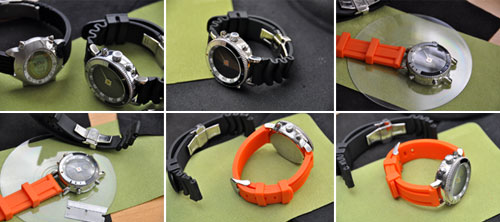
Changing the strap of your favorite watch is a perfect way to give it a new look, a different feel, and get it prepped for new activities. Even if you sit behind a desk all day long, your watch can be ready when adventure calls. Be prepared. The call is coming. [Permalink] -StrappedForTime: Adventure-ready straps
|
|
|
| May 3,2010- MSR MIOX water purifier... |
Lack of clean water is a reality for one out of every six people living today. In some parts of the world, half the population does not have access to safe drinking water. In the United States, the U.S. Environmental Protection Agency (EPA) sets the allowable level of certain contaminants in tap water provided by public water systems. Contaminants in untreated water may include microorganisms such as viruses and bacteria.
Clean water was a sought-after commodity in Boston this weekend. A massive underground pipe rupture which left two million residents without drinking water was a blunt reminder of something most of us take for granted but which many in the world go without everyday. The official city-wide warning went out Saturday afternoon. Boston and 30 surrounding municipalities instructed their residents to boil all water before drinking. This "boil order" was issued because the backup water supply quality was comparable to "untreated pond water," acceptable for bathing and flushing toilets, but not for drinking or cooking.

Fortunately, making water clean enough for drinking was not difficult for us, as we have the MSR MIOX purifier in house. The MIOX will kill much of the harmful biological contaminants in less than 30 minutes: viruses in 15, bacteria in 15, protozoa in 30, and cryptosporidiumin four hours. It does this by creating an oxidant solution which is then poured into the water to destroy any microorganisms. This approach is more effective than clorine or iodine, a lot faster than boiling, and less costly in the long run.
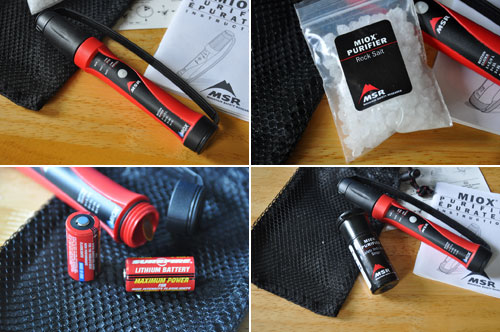
Each purifier utilizes two 3V lithium camera batteries, any type of salt and a tiny electrolytic cell. Rock salt and batteries are included. The CR123 lithium camera batteries will treat about 200 liters of water before needing replacement and have a 10 year shelf-life. They are typically available for about $10 a set. The purifier can be used over and over, making water treatment an inexpensive procedure after the initial purchase. An important feature of using simple salt as the disinfectant source is that salt has an infinite shelf life, so the purifier will still function even if stored without use for a long period of time (4 years since our last use).
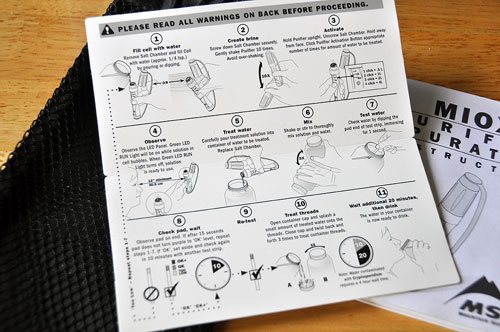
The device operates by converting a brine solution to a mixed-oxidant (hence the name MIOX) solution via electrolysis. The specific steps are simple:
- fill the salt chamber with rock salt,
- cap the salt chamber,
- fill the reaction cell with water,
- screw on the salt chamber,
- shake the pen to mix the water and salt to create brine,
- unscrew the salt chamber,
- activate the brine solution by pressing the button
- pour the activated solution into container of untreated water
- test with indicator strip
- wait 20-30 minutes
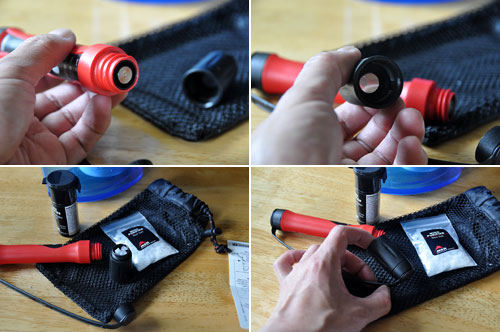
The electrolytic cell has a few metal parts. Looking down from the top into the purifier one sees a 3/8" diameter titanium post in the center; this is the cathode. The inside of the barrel of the plastic outer case is a piece of titanium tubing; this is the anode. An electric current is conducted by the brine solution between the two halves of this electrical circuit to create the MIOX oxidant solution (hypochlorous acid and chlorine).

The ½ teaspoon of mixed-oxidant solution generated by the purifier is poured into a canteen or water bottle and allowed to sit for 30 minutes. The purifier also comes with a vial of purity indicator strips (pH test), which guarantees that the water is safe to drink after the appropriate waiting period. There is also an "overkill" protocol for when one does not have ready access to any test strips.

The MIOX purifier will inactivate all bacteria and viruses within 15 minutes and will inactivate the protozoan cyst Giardia within 30 minutes. Inactivation of the more resistant Cryptosporidium parvum oocyst is NOT required in the EPA Purifier Protocol. In independent testing on the MSR MIOX Purifier, BioVir Laboratories, a government-qualified laboratory employing “Good Laboratory Practices,” started with 100,000 Cryptosporidium oocysts. This excessive concentration of Cryptosporidium would be highly unlikely to occur in natural waters. A three-log (99.9%) removal of 100,000 oocysts would reduce the viable organisms to 100 oocysts. The MSR MIOX Purifier actually achieved more than 10 times the standard for protozoan cysts, accomplishing a four-log (99.99%) removal in 4 hours, which equated to less than 10 viable oocysts, even in the more challenging test water.
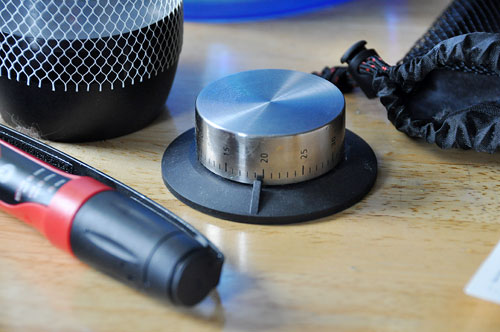
Some folks at RainyDay commented that the taste of treated water was a little "swimming pool-ish." It may be because we had "activated" the solution a few times to get the shot of the green LED :-) In any case, a quick pass of the decontaminated water through the ZeroWater filter took care of the light clorine "flavor." If you want a nice compact/portable water purifier, we can't think of a better choice than this MSR MIOX. Emergencies may not happen all the time, but clean water can be had anytime...if you have the MIOX water purifier. [Permalink] -MSR MIOX Purifier
|
|
| March 29,2010 |
Last November we did an article about ExoVista replacement lenses for our Oakley Juliet sunglasses. We got the ExoVista lenses because they were much less expensive than the OEM Oakley ones.
Recently, we discovered a maker of Oakley lenses from New Zealand who may be our "go to" source for all our future
replacement needs.

We discovered Caulfield lenses when we were looking for an affordable set of Ruby Red replacements. The folks at Caulfield said they were currently updating that particular lens. However, they did provide us with sets of Neon Blue and Brown/Pink Gradient to check out until the new Ruby Reds are available.

The Caulfields are
every bit as sharp and clear as the OEM and ExoVISTA lenses. The edge of the lens is nice and clean. The coating is even. The mirror coating of the Neon Blue Caulfield is higher than that of the OEM, giving the Caulfield a brighter look.
They are every bit as good as the other replacement lenses, just a much better value.

One of the things we like about owning a pair of Oakely Juliet sunglasses is the number different looks we can create just by changing the lenses. The Caulfields are inexpensive enough that it is possible to own a collection of different color lenses and change them as often as our mood suits us. If you are in the market for a set of lenses for your Oakley, Caulfield should be your first (and probably your last) stop.
[Permalink] -Caulfield Lenses
|
|
|
| March 17,2010 |
The average human body is about 70% water. Water is so central to our well being that while a person can live for a few weeks without food, a person can't survive more than a few days without water.
Having access to clean water is something many of us take for granted. The water that comes out of the tap is perfectly fine, but there is an easy way to make it almost perfect.

There are dozens of water filters out in the market. Unlike conventional gravity-fed water filters, ZeroWater's 5-stage ion-exchange filter
is designed to remove everything from the water but the water. The ZeroWater package comes complete with everything needed: dual access pitcher, filtering reservoir, lid, and 5-stage filter.
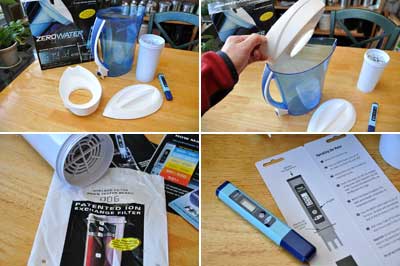
ZeroWater is so confident in their product that they include a laboratory-calibrated water tester in the package. Total Dissolved Solids (TDS) is a measure of the amount of dissolved substances (in parts per million)
in the water. How hard the ZeroWater filter will have to work depends on the quality of the water (level of TDS) being used.

Assembing the filter is a straightforward process. The filter screws into the reservoir from the bottom. There is an integrated silicon 0-ring in the filter for a water-tight seal.
Once assembled, the unit is lowered into the pitcher and ready for use.

To use, fill the reservoir with cold tap water and let the filter do its thing. The rate of filtering is automatic. It took about 4 minutes (with a new filter) to filter one full reservoir of water.
The filtered water may be poured from the pitcher spout on the top or from the bottom via the push-button spout.
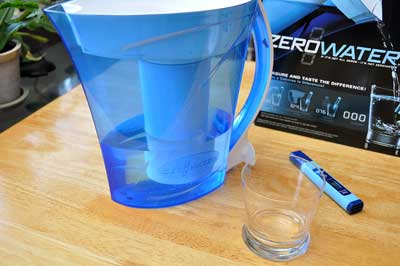
Now that we have some ZeroWater, we plan to give that probe a workout. In our FirstUse write-up we'll see how it compares to: the Pur filter we have been using on the kitchen faucet; a few different brands of bottled water; and Boston's own tap water. It could be quite an eye-opener!
[Permalink] -ZeroWater FirstLook
|
|
|
| March 12,2010 |
When I was growing up, the Swiss Army knife was the tool of choice for anyone looking for something a little more versatile than just a simple folding pocket knife. Leatherman changed all that in the early 1980s with the Pocket Survival Tool.
They have continued to lead the multi-tool category with innovative updates such as the Skeletool.
The great thing about the multi-tool market is that it is constantly evolving, and is also a favorite proving-ground for up-and-coming tool companies and innovative knifemakers.
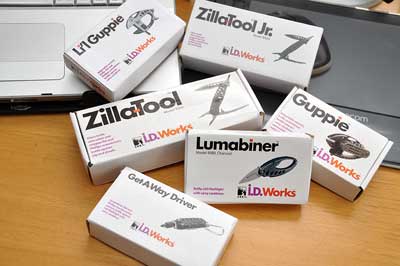
Columbia River Knife and Tool (CRKT) is such
a company, and their designs are certainly innovative.
They have only been in business for fewer than 10 years, but have already made quite a reputation for themselves amongst certain circles. They built their reputation as makers of functional edged-tools that were simple and tough-as-nails. Their first hit was the K.I.S.S folding knife designed by Ed Halligan. In 2008, CRKT came out with the I.D.Works line of multi-tool products.
These tools are not of the traditional folding design. They are more direct.
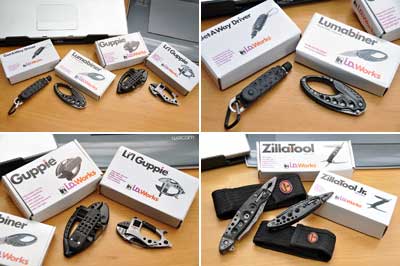
These tools are traditional in function, but not in their design. They clip on, have bits that can interchange, and many have an integrated LED light. Take the Lumabiner for example. This folding knife/LED light combo
should be on every keychain.
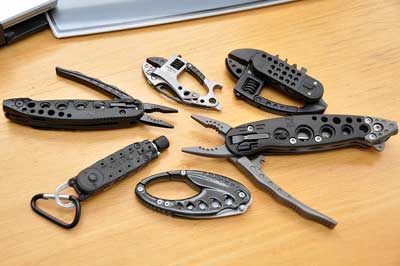
Even during this quick preview of the CRKT multi-tools, one thing was apparent. While the cost of these tools is very modest, CRKT did not skimp on the quality of the materials. In a few weeks we will have a much more detailed look at each of them. CRKT may not have the brand recognition of some of the more established players, but if they continue on this trajectory, they most certainly will...and it will be sooner rather than later. [Permalink] -CRKT I.D.Works FirstLook
|
|
|
| February 10,2010 |
The Washington DC area shutdown on Monday. We, in the NorthEast, are braced for a snow storm scheduled to arrive tonight. Depending on the area we can expect between 4" and 18" of the white stuff. What perfect timing!!! We will take our ColdAvenger Pro out for its FirstUse trial :-)
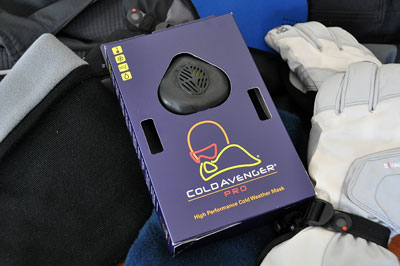
The ColdAvenger is a product from Talus Outdoor Technologies. These folks are located in the Northern Rocky Mountains of Montana so they know about cold. Their motto is "Stay Out Longer."
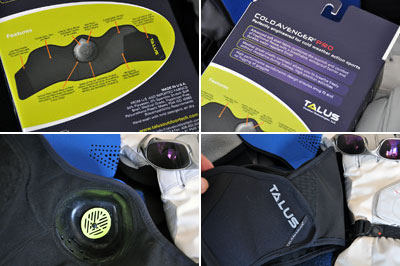
The ColdAvenger mask is made with a stretchy soft shell encasing a medical grade plastic ventilator. The mask is windproof, water repellent, and fits snugly even when wearing a helmet. The generous velcro fastener makes it easy to custom-fit the mask around the face, forming a breathable barrier against the cold.

The interior of the nose cone has an adjustible vent which may be turned to reduce the air flow by up to 40%. It removes easily for cleaning. There is a foam nose piece which may be added to the cone for an even better fit and to help prevent fogging of eyewear.
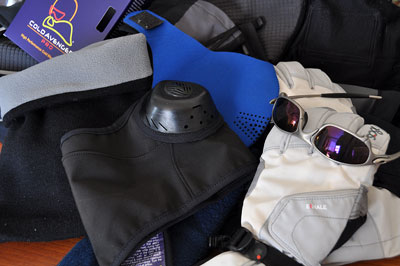
We, for one, are looking forward to this storm as we plan to take the ColdAvenger out and see how it compares to all of the other masks we have in the RainyDaySports office. Look for the ColdAvenger FirstUse report when we come back in. If this mask is as good as the claims by Talus, we may be outside a good long time! [Permalink] -ColdAvenger FirstLook
|
|
|
| February 8,2010 |
Timex is one of our favorite watch companies for a lot of reasons. We love Timex watches for their durability, but they keep us coming back because of the new styles. When we visited the Timexpo museum in December, the museum store was having a 40% off sale, so we picked up this Expedition E-Compass model on impulse.
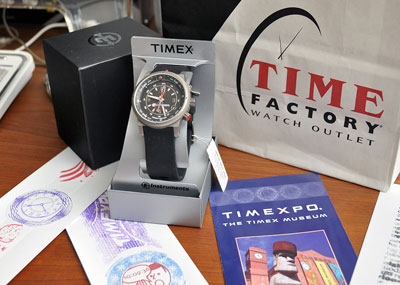
We have had it for a few months now and are still completely satisfied with our purchase. The E-Compass
is just one of the models in the Timex Expedition line. This one is slightly more expensive because of the titanium case. We preferred it to the stainless steel version as it was significantly more light-weight and has a more subtle non-reflective grey finish.
The watch back is made of stainless steel and is deeply etched with the E-Compass logo.
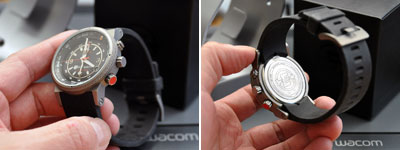
The watch is easy to set up, simple to use, and easy to read day or night. There are several sets of markings on the face of the watch: 12/24 hours, compass, and declination adjustments. There are three different crowns on the right side of the watch.

The upper crown activates the compass function, the middle crown adjusts and activatea the INDIGLO backlighting, and the lower crown move the internal
compass ring.

A compass hand points to “magnetic north,” which may be slightly different from “true north,” which is used on maps. This difference, called the “declination angle,” varies around the globe and is typically small and can be ignored in many cases. However, this watch allows the user to compensate for this difference. With the proper declination angle compensation, the compass hand will point to true north instead of magnetic north.

The silicone strap is soft and very comfortable, but does tend to pick up more dust than we would like. However, as the watch is water-resistant to 100 meters, a quick rinse under running water will usually take care of the problem. Just don't dry your hands afterwards with a linty towel.
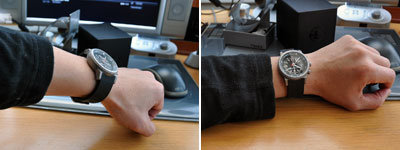
The patented electroluminescent technology used in the INDIGLO® night-light illuminates the entire watch face at night and in low light conditions.
Pressing the center crown will activate the light for about five seconds.
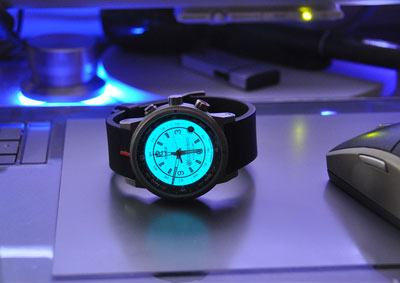
The Timex E-Compass Expedition is fast becoming one of our favorite "go to" watches for all occasions. It is light, functional, and tough as nails. We will continue to put the watch through the fire this Spring and Summer. Look for the InTheWild update in the Fall. [Permalink] -Timex E-Compass Expedition
|
|
|
|
|
|



